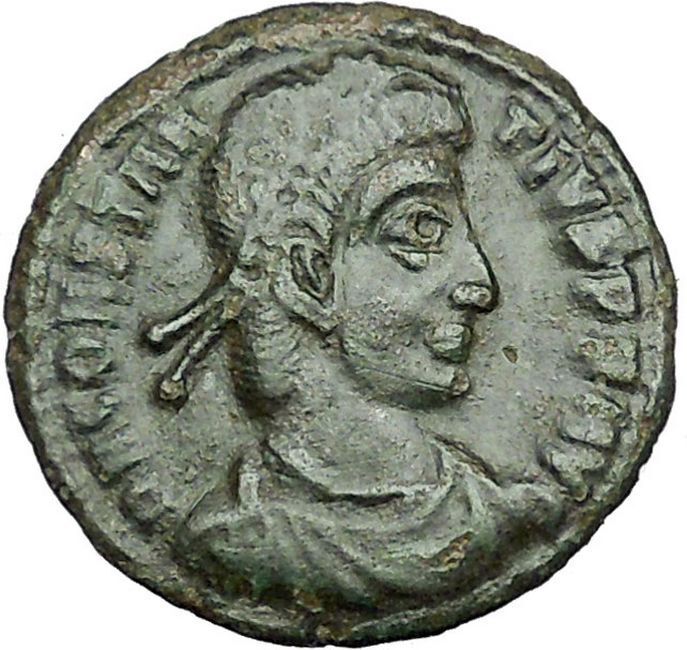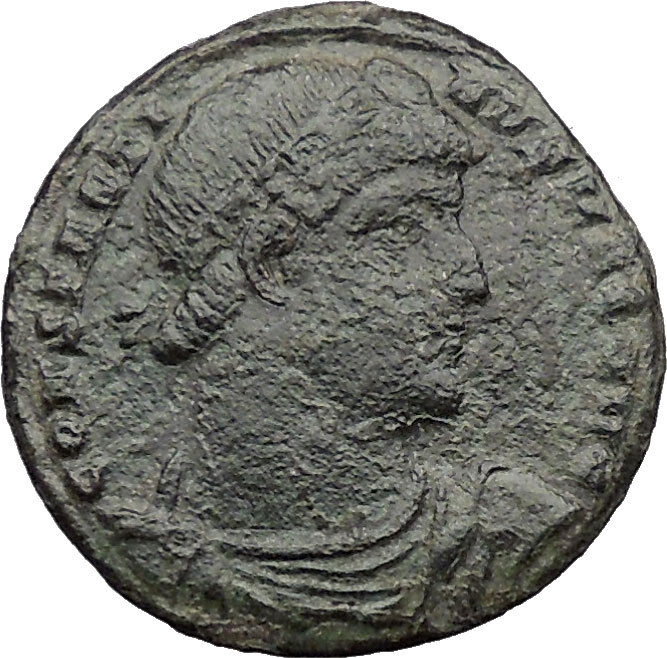|
Anonymous Bronze Quarter-Nummus 16mm (1.44 grams)
“Pagan Commemorative”, struck under Maximinus II Daia 310 AD.
Reference: Vagi 2955
IOVICONSERVATORI – Jupiter seated left, holding globe and scepter.
VICTORIAAVGG Exe: ÃŽâ€�/Ã�„/ANT – Victory (Nike) advancing
left, holding wreath and palm branch.
You are bidding on the exact item pictured,
provided with a Certificate of Authenticity and Lifetime Guarantee of
Authenticity.
PAGAN COINAGE OF THE GREAT PERSECUTION
Though formerly attributed to the period of Julian II, these pieces were struck
c. 305-313 as part of The Great Persecution of Christians in the east by
Diocletian, Galerius and Maximinus II Daia. Though the persecution of Christians
had occured under many previous regimes since the 1st Century, it was pursued
assidu¬ously by the Tetrarchs. Indeed, it was only halted (it would seem) when
they deter¬mined that it was working to the advantage of Constantine the Great,
who embraced the religion as a result. Associated with the persecution is a
series of ‘autonomous’ coins struck at the cities of Antioch, Nicomedia and
Alexandria. The bulk of these coins were probably struck c. 310-312 under
Galerius or Maximinus Daia (though the issues of Nicomedia can perhaps be
attributed to Galeria Valeria, the second wife of Galerius). The issues of
Alexandria occur in two denominations and celebrate Serapis and Nilus. With the
voluminous issues of Antioch we find a variety of mint marks, officinae and
control marks, which suggest the output was large and complex. Depicted on the
issues of Antioch are some of the city’s most famous statues: the Tyche erected
by Eutychides (a pupil of Lysippus), the Apollo by Bryaxis of Athens, and
possibly the Zeus Nikephoros of the Temple of Apollo at Daphne which Antiochus
IV commissioned for his great festival of 167 B.C.
In
Roman mythology
,
Jupiter
or
Jove was the
king of the gods
, and the god of
sky and
thunder
. He
is
 the equivalent of Zeus the equivalent of Zeus
in the
Greek pantheon
. He was called Iuppiter (or Diespiter)
Optimus Maximus (“Father God the Best and Greatest”). As the patron deity of
ancient
Rome
, he ruled over laws and social order. He was the chief god of the
Capitoline Triad
, with sister/wife
Juno
. Jupiter is also the father of the god
Mars
with Juno. Therefore, Jupiter is the grandfather of
Romulus and Remus
, the legendary founders of Rome. Jupiter was venerated in
ancient Roman religion
, and is still venerated in
Roman Neopaganism
. He is a son of
Saturn
, along with brothers
Neptune
and
Pluto
.
He is also the brother/husband of
Ceres
(daughter of Saturn and mother of
Proserpina
),
brother of Veritas
(daughter of Saturn), and father of
Mercury
.
In
Greek mythology
,
Nike was a
goddess
who personified
victory
, also known as the Winged Goddess of
Victory. The Roman equivalent was
Victoria
. Depending upon the time of various
myths, she was described as the daughter of
Pallas
(Titan) and
Styx (Water) and the sister of
Kratos
(Strength),
Bia
(Force), and
Zelus
(Zeal). Nike and her siblings were close
companions of Zeus
, the dominant deity of the
Greek pantheon
. According to classical (later)
myth, Styx brought them to Zeus when

the
god was assembling allies for the
Titan War
against the older deities. Nike
assumed the role of the divine
charioteer
, a role in which she often is
portrayed in Classical Greek art. Nike flew around battlefields rewarding the
victors with glory and fame.
Nike is seen with wings in most statues and paintings. Most other winged
deities in the Greek pantheon had shed their wings by Classical times. Nike is
the goddess of strength, speed, and victory. Nike was a very close acquaintance
of Athena
, and is thought to have stood in
Athena’s outstretched hand in the statue of Athena located in the Parthenon.
Nike is one of the most commonly portrayed figures on Greek coins.
Names stemming from Nike include amongst others:
Nicholas
, Nicola, Nick, Nikolai, Nils, Klaas,
Nicole, Ike, Niki, Nikita, Nika, Niketas, and Nico.
In
Roman mythology
, Victoria was the personification/Goddess of victory.
She is the Roman version of the
Greek goddess
Nike
, and was associated with
Bellona
. She was adapted from the
Sabine
agricultural goddess
Vacuna
and had
a
temple
on the
Palatine Hill
. Her name (in Latin) means victory. Unlike the Greek Nike, Victoria (Latin
for “victory”) was a major part of Roman society. Multiple temples were erected
in her honour. When her statue was removed in 382 AD by emperor
Gratianus
there was much anger in Rome. She was normally worshipped by
triumphant
generals returning from war. Also unlike the Greek Nike, who was known for success in athletic games such
as chariot races, Victoria was a symbol of victory over death and determined who
would be successful during war. Appearing on Roman coins, jewelry, architecture, and other arts, Victoria is
often seen with or in a
chariot
. An
example of this is her place upon the
Brandenburg Gate
in Berlin, Germany.

Gaius
Valerius Galerius Maximinus (20 November, c. 270 – July/August, 313)
Roman emperor
from 308 to 313, was originally named Daia. He was born
of peasant stock to the half sister of the Roman emperor
Galerius
near their family lands around
Felix Romuliana
; a rural area now in the Danubian region of
Misia
today
Bulgaria, then the newly reorganised Roman province of
Dacia Aureliana
subordinated to the later
Prefecture of Illyricum
).
He rose to high distinction after he had joined the army, and in 305 he was
adopted by his maternal uncle,
Galerius
,
and raised to the rank of
caesar
, with
the government of
Syria
and
Aegyptus
.
In 308, after the elevation of
Licinius
to
Augustus
, Maximinus and
Constantine were
declared filii Augustorum (“sons of the Augusti”), but Maximinus probably
started styling himself after Augustus during a campaign against the
Sassanids
in
310.
On the death of Galerius, in 311, Maximinus divided the Eastern Empire
between Licinius and himself. When Licinius and
Constantine
began to make common cause with one another, Maximinus entered
into a secret alliance with the usurper Caesar
Maxentius
,
who controlled Italy. He came to an open rupture with Licinius in 313, he
summoned an army of 70,000 men, but still sustained a crushing defeat at the
Battle of Tzirallum
, in the neighbourhood of
Heraclea Pontica
, on the April 30, and fled, first to
Nicomedia
and afterwards to
Tarsus
, where he died the following August. His death was variously ascribed
“to despair, to poison, and to the divine justice”.
Maximinus has a bad name in
Christian
annals, as having renewed persecution after the publication of the
toleration edict of Galerius (see
Edict of Toleration by Galerius
).
Eusebius of Caesarea
, for example, writes that Maximinus conceived an
“insane passion” for a Christian girl of
Alexandria
,
who was of noble birth noted for her wealth, education, and virginity – Saint
Catherine of Alexandria
. When the girl refused his advances, he exiled her
and seized all of her wealth and assets.
|





 the equivalent of Zeus
the equivalent of Zeus




